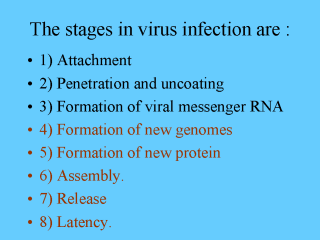| front |1 |2 |3 |4 |5 |6 |7 |8 |9 |10 |11 |12 |13 |14 |15 |16 |17 |18 |19 |review |
 |
4) Formation
of new genomes which may be aided by early proteins which are either viral
polymerases, see above, or promoting cell division to provide new cells for the madly
dividing viruses. 5) Formation
of new protein is always on the host cell ribosomes. Early proteins are
viral enzymes e.g. polymerases (see above) or viral growth factors which stimulate cell
division to provide new host cells for virus. 6) Assembly. Nucleocapsid of DNA viruses are assembled the nucleus.
Nucleocapsid of RNA 7) Release. Release of many particles at once when the cell dies and then bursts. Or each enveloped virus particle gradually buds from the cell surface. 8) Latency - certain viruses, the herpes and retro's, form ± DNA during replication and this can remain latent in the nucleus for years but then become reactivated to make new particles during immunosuppression. |